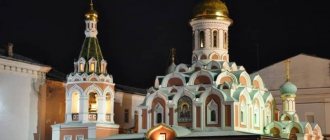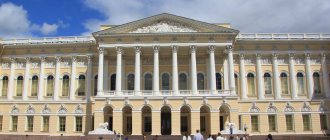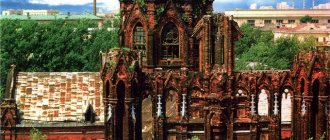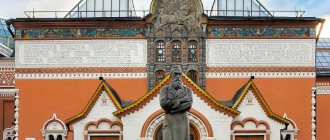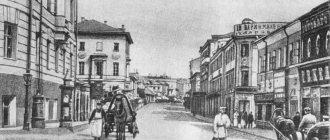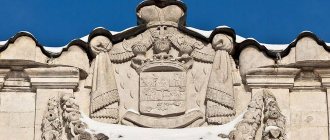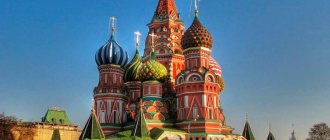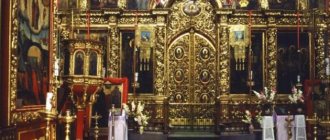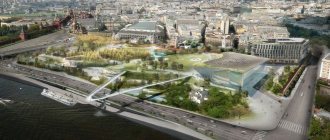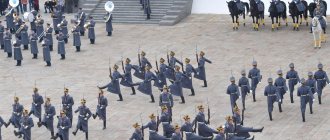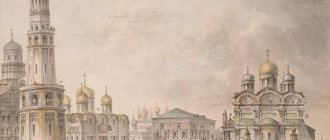The Kazan Cathedral on the corner of Red Square in Moscow has a difficult fate. It was completely demolished in 1936 and rebuilt 57 years later. Today it is a functioning temple where services are held. The main shrine of the cathedral, which believers from all over the country come to worship, is the Kazan Icon of the Mother of God, revered as miraculous, with its relic guardian. The rector of the temple is Archpriest Nikolai Inozemtsev.
Tourists most often visit the cathedral when visiting the main attractions of the capital - Red Square, Alexander Garden, St. Basil's Cathedral, State Historical Museum and other popular sites near the Moscow Kremlin.
© Igor Butyrskii
Hotels near the Kazan Cathedral in Moscow
Schedule of services of the Kazan Cathedral on Red Square
Those wishing to receive the Sacrament of Baptism can contact the ministers for a public conversation every Saturday at 15:00.
Religious events take place daily in the temple:
- 08:00 (weekdays) 08:30 (Sat) and 09:00 (Sun) - liturgy,
- 14:00 (Sat) - Unction
- 17:00 - evening services (parastas, all-night vigil).
On the website of the Kazan Cathedral you can see a detailed schedule of events for the current month, as well as find out the names of the clergy who will conduct the rituals and their assistants.
© Official website of the Moscow Patriarchate
Schedule of services 2021 on the official website of the Cathedral of the Kazan Icon of the Mother of God
Icon of the Moscow Kazan Cathedral
The Kazan Icon of the Mother of God is one of the most revered shrines not only in the Kazan Cathedral, but in Christianity in general. It is worth noting that the temple does not store the original icon, but a copy of it, but this does not detract from its significance. There is a copy in the Dmitrovsky chapel.
© Official website of the Moscow Patriarchate
The first appearance of the icon of the Mother of God happened in 1579 in Kazan. Its location was shown by the girl Matrona, who had a prophetic dream. After its discovery, the icon was repeatedly moved to other churches in the country; many copies were made from it, practically indistinguishable from the original.
To avoid damage and theft, copies were often displayed in churches, and the original was carefully guarded. However, in 1904, the icon was stolen; the thief turned out to be the peasant Chaikin, who said that he burned the relic. Later, versions were put forward according to which the destruction of the Kazan Icon of the Mother of God was called into question. Until now, historians cannot come to a definite opinion whether the original of the Kazan Icon of the Mother of God has survived and where it may be located.
Architectural and cultural landmarks
- Colonnade of the Kazan Cathedral. Architect A. Voronikhin, at the request of Emperor Paul I, repeated the Roman creation of D. Bernini, erecting on the northern side of the cathedral a colonnade of 94 pillars 14 m high and weighing about 28 tons. But if in Rome the cathedral columns are simply decoration of the square, then in St. Petersburg they are in a semicircle fit into Nevsky Prospekt and cleverly hide the asymmetry of the building: the church is Orthodox, and its main entrance is from the west, that is, from Kazanskaya Street, and the dome is not in the middle, as in the Catholic tradition, but to the east of the entrance. If you look at the Kazan Cathedral in St. Petersburg in the photo, you may not notice this subtlety. The material for the columns was a stone similar to travertine - the stone used for exterior work in the Cathedral of St. Petra. It was mined without much effort in the village of Pudost, 49 km from St. Petersburg.
- Monuments near the Kazan Cathedral. Despite the fact that the building itself has a religious meaning, on the territory of the cathedral there are bronze sculptures of two famous commanders - M. Kutuzov and M. Barclay de Tolly. At the request of Emperor Nicholas I, they are depicted on pedestals in military uniforms, which they wore during their lifetime, and personify different stages of the war with Napoleon: under Barclay, Russian troops temporarily retreated, and Kutuzov defeated them completely. A trio of masters - B. Orlovsky, V. Ekimov and S. Sukhanov - completed work on the monument to Kutuzov at the Kazan Cathedral in 1831, and the statue of Barclay in 1835. Although the monuments were erected in their rightful places at the same time, in 1837, celebrating 25th anniversary of the victory over Napoleon's army. A century later, soldiers of the Soviet army took the oath near the statues.
Field Marshal's grave
Many Russian cathedrals can boast that they are the final resting places of famous families, religious or political figures. The Cathedral on Kazan Square is no exception. Who is buried in the Kazan Cathedral of St. Petersburg? Here is buried the one whose life was closely intertwined with the history of the cathedral - Field Marshal M. Kutuzov. As military governor of the city, he assisted in the construction of the cathedral and took command of the army only after praying here. When the field marshal died during the campaign of 1813, Emperor Alexander I decided to leave the commander’s body forever in the Kazan Cathedral. True, the coffin wandered around Europe for 2 months to reach its resting place. The architect of the cathedral, A. Voronikhin, provided Kutuzov with a posthumous service by taking care of the design of his burial. On top of the embalmed remains they hung an icon of Our Lady of Smolensk and, confirming Kutuzov’s military status, 6 sets of keys to the captured cities (Brussels, Nancy and Aachen). There was a legend that the field marshal's heart remained in the battles of battles with his soldiers. In 1933, when the zinc coffin was opened, the myth was dispelled: the heart of the brave commander rested in a silver jar next to the remains. Despite this, Kutuzov’s grave in the Kazan Cathedral remains a unique military symbol of Russia.
History of the temple
The first cathedral building, built in the 1620s, was made of wood. The construction of a new temple dedicated to the war of 1612, in which Russia won, was sponsored by Dmitry Pozharsky. The building was damaged in a fire and was rebuilt in the 1630s. Until 1765, on days of celebration of particularly significant events (military victories, discovery of an icon), religious processions were held before the Kazan Cathedral.
In subsequent years, the temple was rebuilt and repaired several times. The last restoration took place in 1925. Architect Pyotr Baranovsky wanted to return the building to its original appearance. The work lasted for 4 years, and when very little remained, the Moscow City Council decided to demolish the temple. The restoration stopped, the bell tower was destroyed in the same year, and the cathedral premises were used until 1936 as a warehouse for storing building materials for the metro station. After the demolition of the Kazan Cathedral, a pavilion in honor of the Third International was placed in its place.
In 1990, the Moscow authorities decided to rebuild the cathedral, and therefore began collecting donations. The shrine was restored using photographs and drawings preserved in the archives. Work on recreating the Cathedral of the Kazan Icon of the Mother of God ended in 1993.
Panorama of the temple from Red Square:
Conducting religious services
The Church on Red Square in Moscow is a museum and an architectural monument, therefore permanent services are prohibited there, except for the Liturgy and the subsequent akathist to Blessed Basil in his chapel. The Liturgy begins at 10:00.
An additional service is held on Bright Tuesday after Easter. Services for patronal feasts are also held in each chapel.
Architecture
The Cathedral of the Kazan Icon of the Mother of God is a typical example of temple architecture of the first half of the 17th century. This is a single-domed temple with two chapels. The northern and southern aisles are united by a gallery that surrounds the structure on three sides.
The exterior of the cathedral is decorated with mosaic icons in the Russian style. They depict the Mother of God, Jesus Christ, St. George the Victorious, the Patriarch of Moscow and other saints.
© Official website of the Moscow Patriarchate
How to get there
The Kazan Cathedral is located in the center of Moscow on Nikolskaya Street. Getting to it is not difficult - several metro stations and public transport stops are within walking distance from the shrine. You can also take a taxi or go by car.
Metro
The metro is perhaps the most convenient transport in the capital. From the station closest to the cathedral, “Okhotny Ryad” (red line), walk only about 100 meters from exit No. 7. In addition, the Teatralnaya station (green line) is nearby, and a little further “Revolution Square” (blue line).
Moscow metro map - Yandex. Metro
View of the cathedral from Nikolskaya street:
Public transport
300 meters away, near the Okhotny Ryad metro station, there are stops: Okhotny Ryad Metro and Manezhnaya Ploshchad. Buses and minibuses run here: No. M2 (to Rizhsky Station), M3, M10, M27, N1 (night to Sheremetyevo Airport), N2 (night), H11 (night to Vnukovo Airport), 101, 144, 904 .
A little further (on the opposite side of Red Square, near St. Basil's Cathedral) there is another bus stop - “Red Square”. Buses No. M5 and 158 depart from it.
Moscow public transport portal
Description of appearance
The temple on Red Square in Moscow is an example of Russian architecture. When viewed from above, it is a strict geometric composition consisting of two squares of different sizes. Their arrangement at an angle to each other makes up a “custody” - the figure of an eight-pointed star.
Each corner of the star forms one of the 8 temples, and in the center is the 9th and main church. Such a number of thrones and such an idea have a deep meaning in Orthodoxy: the number 8 itself is quite symbolic, it marks the Resurrection of Christ, and the custodia is an ancient symbol of the Mother of God.
The 4 sides of the square are at the same time the cross, and universality, and the 4 Gospels. The 9th, central dome, in turn symbolizes the unification and patronage of the Mother of God over Russia.
Inside, all the churches are united by one common foundation, an internal gallery and vaulted passages. The temple is skillfully decorated with paintings, various ornaments and designs, but the outside was not always so colorful and bright. Colorful domes and iridescent tents were added later, after construction, and the interior ornaments of each church are different.
The height of the temple is 65 m; for a long time it was the tallest building in Moscow.
The temple does not have a main entrance; each of its sides can be considered a façade. Later, another St. Basil's chapel and a bell tower were added to the main structure.
The number of domes also changed over time. Initially, there were 25 large and small domes over the temple, then their number was reduced to 10: each over its own temple, over the bell tower and an additional chapel. Onion-shaped domes are individual and not repeated.
